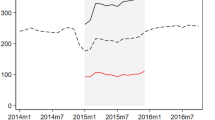Abstract
Public employment offices match job seekers and vacancies. The effectiveness of this matching process depends on the way these offices handle the job vacancies. This article studies the matching process by analyzing the effect of different mediation methods on the duration of job vacancies. The results suggest that intensive mediation reduces average vacancy duration, indicating that public employment offices can improve the matching process.
Similar content being viewed by others
References
Barron JM, Bishop J, Dunkelberg WC (1985) Employer search: The interviewing and hiring od new employees. Review of Economics and Statistics 67:43–52
Barron JM, Mellow W (1982) Labor contract formation, search requirements, and use of a public employment service. Economic Inquiry 20:381–387
Beaumont PB (1978) The duration of registered. Vacancies: An exploratory exercise. Scottish Journal of Political Economy 25:75–87
Blanchard OJ, Diamond P (1989) The beveridge curve. Brookings Papers on Economic Activity 1:1–76
Blanchard OJ, Diamond P (1992) The flow approach to labor markets. American Economic Review, Papers and proceedings 354-359
Corcoran M, Datcher L, Duncan GJ (1980) Most workers find jobs through words of mouth. Monthly Labor Review 33–35
Devine TJ, Kiefer NM (1990) Empirical Labor Economics, Oxford University Press, Oxford.
Han A, Hausman JA (1990) Flexible parametric estimation of duration and competing risk models. Journal of Applied Econometrics 5:1–28
Jackman R, Layard R, Pissarides C (1989) On vacancies. Oxford Bulletin of Economics and Statistics 51:377–394
Jensen P, Westergard-Nielsen N (1990) Temporary layoffs. In: Hartog J, Ridder G, Theeuwes J (ed) Panel Data and Labor Market Studies, North-Holland, Amsterdam
Lindeboom M, Theeuwes JJM (1991) Job duration in the Netherlands: The co-existence of high turnover and permanent job attachment, Oxford Bulletin of Economics and Statistics 53:243–264
Narendranathan SW, Stewart MB (1990) An examination of the robustness of models of the probability of finding a job for the unemployed. In: Hartog, J, Ridder G, Theeuwes J (ed) Panel Data and Labor Market Studies, North-Holland, Amsterdam
Ours JC van, Ridder, G (1992) Vacancies and the recruitment of new employees. Journal of Labor Economics 10:138–155
Ours JC van, Ridder G (1993) Vacancy durations: Search of selection?, Oxford Bulletin of Economics and Statistics, 55:187–198
Pissarides CA (1990) Equilibrium Unemployment Theory, Basil Blackwell, Oxford
Rees A (1966) Information networks in labor markets. American Economic Review 559–566
Roper S (1988) Recruitment methods and vacancy duration. Scottish Journal of Political Economy 35:51–64
Author information
Authors and Affiliations
Additional information
The author wishes to thank the Ministry of Social Affairs and Employment for its financial support and the use of the public employment office data, and wishes to thak Cees Gorter, Wim Groot, Gusta Renes and Geert Ridder for their comments on a previous version of the article. The author also wishes to thank Wim v.d. Bij for his research assistance.




